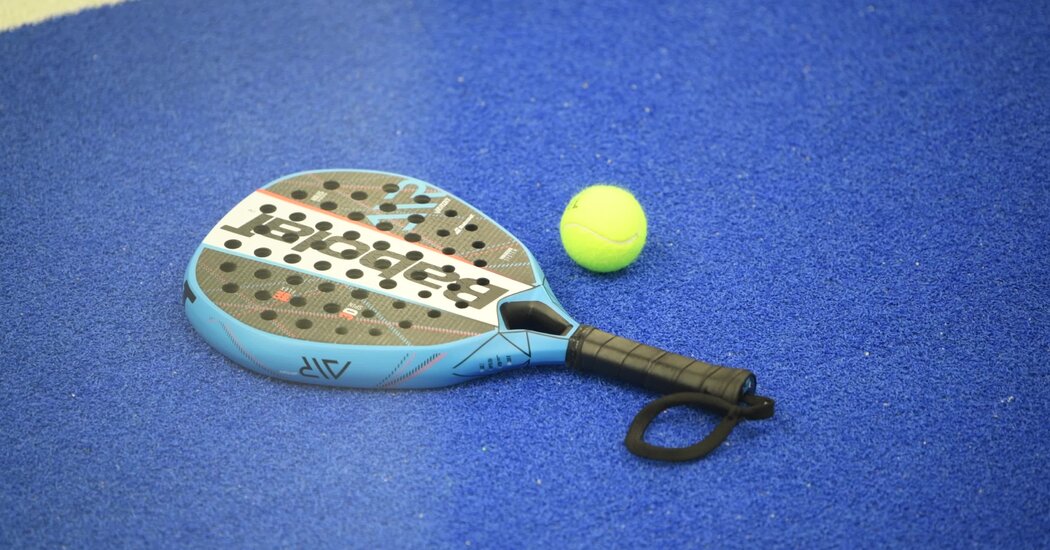I first learned about padel last summer, when my partner sent me a photo from a small court during a visit to Germany.
What is that? I wondered.
“Padel. A childish version of tennis,” he texted, anticipating my question.
As an enthusiastic tennis player, I was not very interested.
A few months later, while biking in Williamsburg, Brooklyn, I noticed a large building with a sign that read “Padel Haus,” which billed itself as the first padel club in New York City. This sport wanted my attention, so I invited Victor Mather, a veteran sports reporter, to join me for a lesson.
Victor was willing to try. “I am a reasonably fit guy,” he said. But he was turning 60, he said, and added: “My eyesight isn’t what it used to be, I haven’t played tennis since prep school, and I have never played squash or racquetball.”
I was just happy to be on a court with a racket in hand because it isn’t easy to book a tennis court in the city.
Here’s what we learned.
First, what is padel?
At first glance, it looks like tennis.
The sport — a blend of squash and tennis — can be played indoors or outdoors. It is always played on turf, which is softer on the knees than the paved hardcourts associated with tennis and outdoor pickleball. The padel racket, usually made of foam and carbon fiber or fiberglass, is shorter than tennis’s and has holes instead of strings. The ball is smaller as well and has less air pressure.
The scoring is like tennis’s. There are glass walls at the back and sides of the court. The walls are in play, setting up ricochet shots that bring the squashiness into padel.
The serves are hit from below the waist. Players are encouraged to rush the net after serving. Padel is played in doubles and teams can move as a unit rather than staggered.
Santiago Gomez, Padel Haus’s founder, grew up playing in Mexico, where the sport was created in the late 1960s. He spent much of the Covid-19 pandemic in Acapulco and decided to start his business when he returned to New York City, opening a club in 2022.
The sport is growing in popularity.
Elmo Coleman, 27, learned padel in Venice during the coronavirus pandemic. But he dropped the sport when he moved to New York City for lack of places to play. He played tennis, begrudgingly. Now he plays padel three times per week in Dumbo.
The sport has been growing in popularity in places like South Florida, Texas, Southern California, and New York, according to the United States Padel Association.
There were 180 courts across the United States in 2022, compared with fewer than 20 in 2016, according to a Global Padel report from Playtomic, a community of players that prepared the analysis with the consulting firm Monitor Deloitte. The U.S.P.A. estimates that there are 50,000 players and 400 courts now, not including private ones.
Globally, padel players number in the millions, the U.S.P.A. says.
“Padel is very much in its infancy in the U.S.A.,” said Martin Sweeney, the association’s president. “We do expect some exponential growth over the next few years and into the future.”
It’s appealing to fans of racket sports.
The first wave of players who visited the Padel Haus locations in Brooklyn (there are two in Williamsburg and one in Dumbo) were from other countries, Mr. Gomez said. The second wave included tennis players.
On a recent winter day, the four courts in a former warehouse with 30-foot ceilings in Dumbo were full. Sunlight trickled in through enormous glass doors, and “Can’t Stop Your Lovin’” by Panama and Poolside sounded on the speakers.
“Tennis is very complicated to play in New York,” Mr. Coleman said after playing for two and a half hours. “The demand is so high that it’s very tough to just book a court and play.”
Some see in padel a less demanding sport.
“It’s very offensive to say, but it’s like tennis for people that are not that good at tennis,” said Virgilio Contucci, 27, who works in finance. “This is, like, an easy way to enjoy a racket sport.”
The main demographic attracted to the courts in Brooklyn has been young men, but that’s changing, Mr. Gomez said.
“It’s raining men; I’m not complaining,” said Talia Campbell, a 30-year-old who works in private equity, as she came off the court.
The costs to book a court can vary widely.
The sport can be costly, at least in New York. At Padel Haus, renting a court costs $65 an hour at peak weekend times, from 9 a.m. to 2 p.m. Members pay $37.50 per hour; membership at one location is $140 a month. The lower-cost times are 9 a.m. to 4 p.m. Monday through Friday: $25 for members and $40 for nonmembers. The hourly fees do not include racket rentals or balls. (The New York Times paid $195 for our private, one-hour lesson.)
“I feel like the only thing preventing all of us from playing more is the price,” said Will Elkins, 26, who works in finance.
There is also a pop-up padel site in Manhattan, which is not open year-round. The cost can vary outside of New York for court access, from free play to $40 to hundreds per session.
Now, it’s time to play.
For our lesson, Victor and I walked onto the artificial turf and marveled at the high ceilings.
We grabbed our rackets and stood across the net from our coach, who walked us through how to hold and swing the racket. The grip is the same one used for serving and volleying in tennis.
We alternated hitting forehands and backhands. Next, we tried to get the timing down as the coach hit balls deep into the court. We let them bounce against the wall before trying to send them over the net. That was the hardest part.
“After whacking the first couple of balls over the net successfully, I felt a surge of confidence,” Victor said later. But that “ended abruptly when I chased a lob and slammed directly into something unexpected and unyielding. Oh, that’s right. Padel courts have glass walls.”
He said that it was hard at times to pick up the ball, especially against the lights, and that “the hourlong session was a real workout.” It required rushing the net only to backpedal “again and again,” which may be hard for less-fit players.
As for me, I will definitely play again. I’ve already started asking my friends if they’ve heard of the sport. When they ask what it is, I don’t tell them it’s a childish form of tennis. I tell them it’s a good alternative when you can’t book a tennis court.
Victor Mather played padel for this report.

